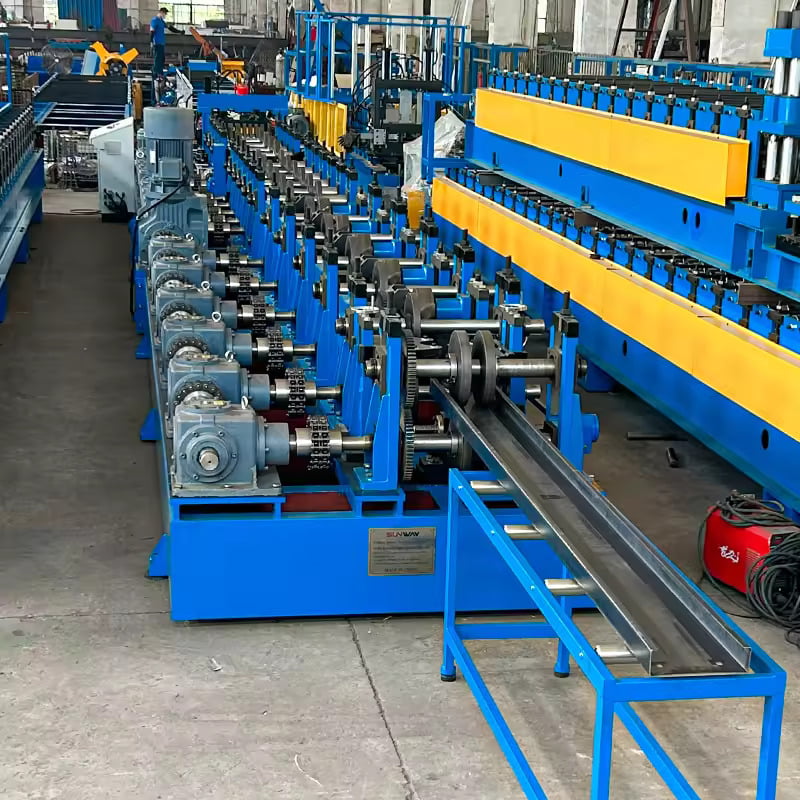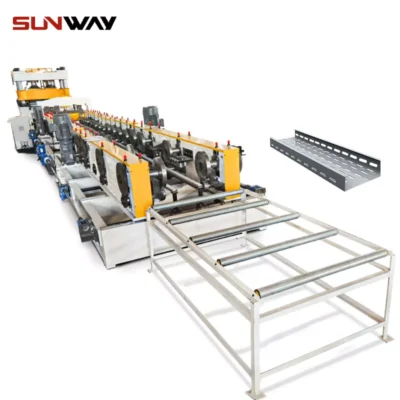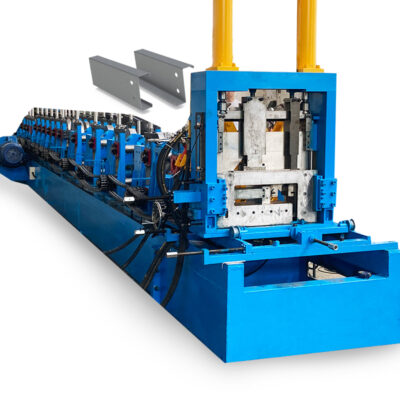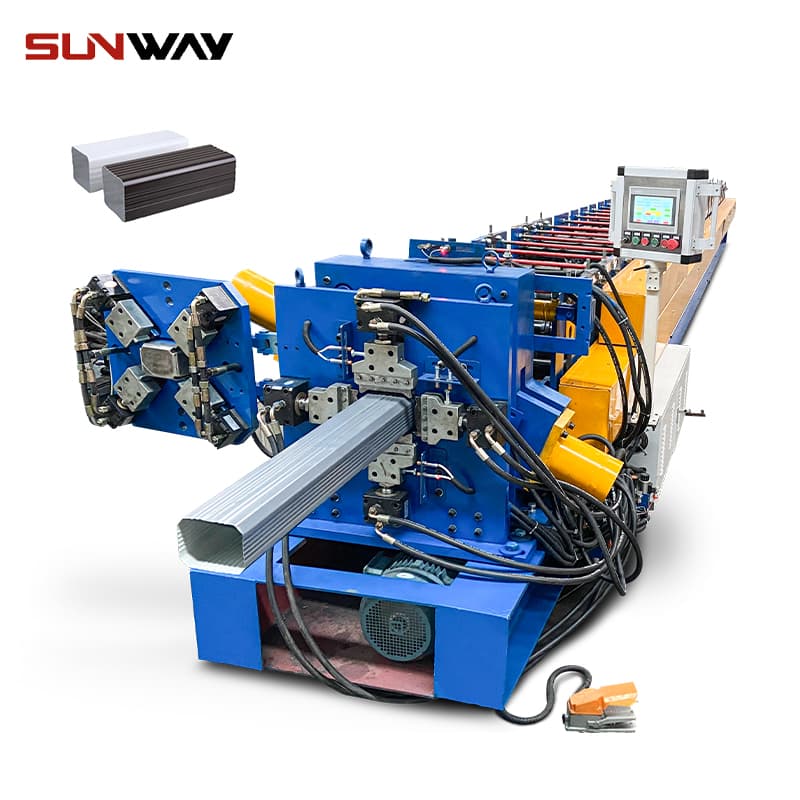Когда речь идет о формовке и литье металла, немногие машины столь же универсальны и незаменимы, как профилегибочная машина. Если вы занимаетесь строительством или производством, или просто интересуетесь промышленным оборудованием, понимание роли и эффективности вальцовочных станков жизненно необходимо. В этом подробном руководстве мы расскажем вам обо всем, что необходимо знать: от того, что делают вальцовочные станки, до различных типов, процессов их работы и даже того, как выбрать лучшего поставщика.
Независимо от того, хотите ли вы получить знания или готовы инвестировать в эту машину, эта статья призвана дать вам всю информацию в одном месте. Итак, пристегните ремни, и поехали!
Что такое профилегибочная машина?
А профилегибочная машина это оборудование, предназначенное для придания плоским металлическим полосам точных профилей. Этот процесс, называемый валковой формовкой, включает в себя подачу металла через ряд последовательных роликов. Каждый набор роликов слегка изгибает металл, пока не будет достигнута желаемая форма поперечного сечения.
Этот метод очень эффективен, особенно при производстве длинных металлических профилей в больших объемах. Рулонное профилирование используется в основном для таких материалов, как сталь, алюминий и медьшироко используется в строительной индустрии для производства таких изделий, как кровельные листы, стеновые панели, и дверные коробки.
Ключевые особенности Формовка рулонов Maкитайцы
- Непрерывный процесс гибки
- Подходит для длинных профилей
- Работает с такими металлами, как сталь, алюминий и медь
- Высокая эффективность производства
- Минимальные отходы материалов
- Возможность изготовления различных форм и размеров

Типы машин для формовки рулонов: Приспособление к различным потребностям
Профилегибочные машины Они бывают разных форм и размеров, каждый из которых предназначен для решения конкретных задач. Здесь мы рассмотрим конкретные типы валковых машинОни делятся на категории по выполняемым функциям.
| Тип машины | Описание |
|---|---|
| Одностоечный станок | Используется один комплект роликов, подходит для простых форм при небольших объемах производства. |
| Многофункциональный станок | Состоит из нескольких роликовых станций для получения более сложных профилей и высокой производительности. |
| Переносной валковый станок | Небольшие мобильные машины, используемые непосредственно на строительных площадках. |
| Прецизионная валковая формовка | Высокоточные станки, используемые для изготовления деталей с жесткими допусками. |
| Автоматизированная формовка рулонов | Полностью автоматизированные машины с минимальным вмешательством человека, повышающие производительность. |
| Высокоскоростная валковая формовка | Рассчитан на высокую производительность, подходит для массового производства. |
| Гидравлическая вальцовка | Использует гидравлическое усилие для гибки более тяжелых и толстых материалов. |
| Сервоприводная машина | Оснащен серводвигателями для более точного контроля над процессом формования. |
| Вальцовочная машина с ЧПУ | Управляется компьютером, что позволяет создавать самые разнообразные формы и профили. |
| Формование рулонов на заказ | Созданы специально для удовлетворения потребностей клиентов, адаптированы для уникальных конструкций изделий. |
У каждого типа машин есть свои плюсы и минусы, в зависимости от требований вашей производственной линии. Понимание того, какая модель соответствует вашим потребностям, поможет вам сэкономить время, деньги и головную боль в будущем.
Как работает роликовая формовочная машина? Полный процесс
Возможно, вы задаетесь вопросом: "Как именно работает вальцовочная машина?". Это увлекательный процесс, который превращает сырой металл в точные профили с помощью непрерывной автоматизированной системы. Ниже мы расскажем, как именно рабочий процесс вальцовочного станка:
Пошаговый процесс формовки рулонов
- Загрузка материала: В машину подаются полосы или рулоны необработанного металла. Чаще всего используются такие материалы, как сталь, алюминий или медь.
- Первоначальное выпрямление: Перед началом формовки материал проходит через выравнивающее устройство, которое разравнивает его.
- Роликовые станции: Полоса проходит через несколько роликовых станций, на каждой из которых металл сгибается еще больше, пока не будет достигнута окончательная форма.
- Резка по длине: После формирования нужного профиля материал разрезается по длине с помощью режущего инструмента - это может быть механический резак или лазер.
- Коллекционирование и штабелирование: Готовая продукция собирается и укладывается в штабеля, готовая к отправке или дальнейшей обработке.
Эта бесперебойная работа отличается высокой эффективностью и минимизацией отходов, что делает ее идеальной для массового производства.
Основные компоненты машины для формовки рулонов и их функции
Каждая деталь вальцовочного станка играет важную роль в обеспечении его бесперебойной и эффективной работы. Давайте рассмотрим основные компоненты и их функции.
| Компонент | Функция |
|---|---|
| Ролики | Отвечает за придание металлу требуемого профиля. |
| Устройство подачи материала | Подает необработанный металл в машину с постоянной скоростью. |
| Выпрямительное устройство | Разглаживает материал перед подачей на роликовые станции. |
| Отсекатель | Отрежьте сформированный металл до нужной длины после придания ему нужной формы. |
| Двигатель (электрический или гидравлический) | Приводит в движение ролики и другие механические части машины. |
| Контроллер (с ЧПУ или ручной) | Управляет работой и регулирует такие параметры, как скорость и усилие. |
| Направляющие валики | Следите за тем, чтобы металлическая полоса выравнивалась при прохождении через машину. |
| Разматыватель | Удерживает и выпускает металлическую катушку в машину. |
| Система перфорации | Пробивает отверстия или пазы в материале в процессе формовки. |
-
 Профилегибочная машина для виноградников
Профилегибочная машина для виноградников -
 Профилегибочная машина Sigma Purlin с автоматическим изменением размера
Профилегибочная машина Sigma Purlin с автоматическим изменением размера -
 Профилегибочная машина для рамы электрического шкафа
Профилегибочная машина для рамы электрического шкафа -
 Профилегибочная машина для DIN-рейки
Профилегибочная машина для DIN-рейки -
 Профилегибочная машина для кабельных лестниц
Профилегибочная машина для кабельных лестниц -
 Профилегибочная машина для профилегибочного профиля PV с монтажным кронштейном C
Профилегибочная машина для профилегибочного профиля PV с монтажным кронштейном C -
 Профилегибочная машина для кабельных лотков
Профилегибочная машина для кабельных лотков -
 Канал Пурлин КЗ формируя профиль машины полностью автоматический гальванизированный стальной
Канал Пурлин КЗ формируя профиль машины полностью автоматический гальванизированный стальной -
 Профилегибочная машина для монтажных кронштейнов PV (профиль HAT / Omega)
Профилегибочная машина для монтажных кронштейнов PV (профиль HAT / Omega)
Скорость и эффективность машины: Что ожидать от роликовых формовочных машин
Один из ключевых факторов, который необходимо учитывать при покупке профилегибочная машина это скорость и эффективность. Это особенно важно, если вы работаете в условиях крупносерийного производства. Давайте рассмотрим типичные скорости и то, как они влияют на производительность.
| Тип машины | Средняя скорость | Эффективность |
|---|---|---|
| Одностоечный станок | 5-10 метров в минуту | Низкая производительность, подходит для небольших серий. |
| Многофункциональный станок | 20-30 метров в минуту | Высокая эффективность, оптимально подходит для сложных и объемных задач |
| Высокоскоростная валковая формовка | 40-100 метров в минуту | Чрезвычайно эффективен для массового производства. |
| Прецизионная валковая формовка | 10-15 метров в минуту | Более низкая скорость, но чрезвычайно высокая точность. |
| Гидравлическая вальцовка | 5-15 метров в минуту | Медленнее, но идеально подходит для тяжелых материалов. |
Индивидуальные механические параметры для рулонных формовочных машин
Каждая производственная линия отличается от другой, поэтому часто возникает необходимость в индивидуальной настройке. Вы можете настроить несколько механических параметров для удовлетворения конкретных производственных потребностей.
| Параметр | Описание |
|---|---|
| Толщина материала | Варьируется от 0,3 мм до 5 мм в зависимости от типа металла. |
| Ширина профиля | Может варьироваться в зависимости от требований заказчика; обычно составляет от 100 до 800 мм. |
| Станции формовки | Количество станций может быть изменено в зависимости от сложности профиля. |
| Длина резки | Регулируется для производства продукции различных размеров, как правило, от 0,5 до 12 метров. |
| Возможности перфорирования | Настраиваемые шаблоны перфорации для отверстий, пазов или вырезов. |
| Мощность двигателя | Возможность регулировки в зависимости от материала и скорости производства. |
| Тип контроллера | Выбирайте между системами с ЧПУ, ручными или полуавтоматическими. |
Области применения роликовых формовочных машин: Где они используются?
Рулоноформовочные машины универсальны и имеют широкий спектр применения. Вот список отраслей и продуктов, где обычно используются эти машины.
| Приложение | Описание |
|---|---|
| Кровельные и стеновые панели | Гофрированные листы используются в строительстве для кровли и облицовки стен. |
| Дверные и оконные рамы | Производит каркасы для жилых и промышленных зданий. |
| Автомобильная промышленность | Создает металлические детали для рам и элементов конструкции автомобилей. |
| Воздуховоды HVAC | Используется при производстве воздуховодов для систем отопления, вентиляции и кондиционирования воздуха. |
| Стальная мебель | Формирует металлические профили, используемые в офисной и промышленной мебели. |
| Электрические шкафы | Производит корпуса для электрических систем и шкафов управления. |
| Рамки для солнечных батарей | Формирует металлические профили для монтажа солнечных панелей на крышах. |
| Системы хранения | Создает полки, стеллажи и другие решения для хранения. |
| Ограждения и перила | Производит защитные барьеры и ограждения для автомобильных дорог и промышленных объектов. |
| Кабельные лотки | Формирует из металла лотки для электропроводки. |
Установка, эксплуатация и обслуживание валковых формовочных машин
Правильная установка, эксплуатация и обслуживание вальцовочного станка очень важны для достижения долгосрочной эффективности и производительности.
| Процесс | Подробности |
|---|---|
| Установка | Требуется правильная центровка машины, электрические соединения и гидравлическая настройка. |
| Операция | Как правило, требуются обученные операторы, которые разбираются в скорости подачи материала и управлении машиной. |
| Техническое обслуживание | Регулярная смазка, чистка и замена износившихся деталей - залог долговечности. |
| Меры безопасности | Включите аварийные остановки, защитные ограждения и регулярные проверки оборудования. |
| Поиск и устранение неисправностей | Такие проблемы, как несоосность материалов или износ роликов, могут быть решены при своевременном вмешательстве. |
Выбор правильного поставщика: Ключевое решение
При инвестировании в валково-формовочную машину выбор правильного поставщика может иметь большое значение. Вот что следует учитывать при выборе поставщика.
| Фактор | На что обратить внимание |
|---|---|
| Диапазон цен | Сравните цены от разных поставщиков. Цены на машины могут варьироваться от $50,000 до $200,000. |
| Репутация | Изучите отзывы клиентов и репутацию компании в отрасли. |
| Поддержка и гарантия | Ищите поставщиков, которые предлагают расширенную гарантию и хорошую послепродажную поддержку. |
| Настройка | Убедитесь, что поставщик может удовлетворить ваши особые потребности в настройке. |
| Расположение | Выбирайте поставщика, способного обеспечить своевременную доставку и поддержку. |
Поставщики и диапазон цен
| Поставщик | Диапазон цен (USD) | Расположение |
|---|---|---|
| Самко Машинери | $60,000 – $150,000 | Канада |
| Jupiter Roll Forming | $50,000 – $180,000 | Индия |
| Йодер | $100,000 – $250,000 | США |
| Ханчжоуская роликовая формовка | $45,000 – $120,000 | Китай |
| Формтек Групп | $80,000 – $200,000 | США |
Плюсы и минусы рулонных формовочных машин: Преимущества и ограничения
Как и любое другое промышленное оборудование, вальцовочные станки имеют свои сильные и слабые стороны. Давайте погрузимся в сравнение плюсов и минусов.
Преимущества
- Высокая эффективность производства: После настройки станок может работать непрерывно, производя большой объем металлических профилей с минимальным временем простоя.
- Универсальность: Может использоваться для широкого спектра материалов и профилей.
- Минимум отходов: Непрерывный процесс валковой формовки сокращает количество отходов металлолома, что делает его экономически эффективным и экологически безопасным.
- Точность: Станки отличаются высокой точностью и производят детали с жесткими допусками.
- Настройка: Легко настраивается для производства различных форм и размеров для различных отраслей промышленности.
Ограничения
- Высокие начальные инвестиции: Первоначальные затраты на приобретение и установку валковой машины могут быть значительными.
- Требуются специализированные навыки: Операторы должны пройти соответствующее обучение, чтобы эффективно работать с машинами.
- Ограниченный объем производства: Рулонная формовка лучше всего подходит для длительного производства, поэтому она менее эффективна при изготовлении небольших партий.
Как выбрать поставщика оборудования для формовки рулонов
Выбор правильного поставщика имеет решающее значение при инвестировании в валково-формовочную машину. Вот основные соображения:
Факторы, которые необходимо учитывать при выборе поставщика
- Репутация: Всегда обращайтесь к поставщикам, которые зарекомендовали себя как поставщики высококачественного оборудования.
- Настройка: Убедитесь, что поставщик может удовлетворить ваши точные требования к конструкции и производительности машины.
- Службы поддержки: Послепродажная поддержка, включая установку, обслуживание и ремонт, является обязательной.
- Цена: Хотя цена важна, она не должна быть единственным решающим фактором. Сосредоточьтесь на ценности, предлагаемой поставщиком.
- Гарантии: Поставщик, предоставляющий хорошую гарантию, говорит об уверенности в своем продукте.

Часто задаваемые вопросы
| Вопрос | Ответ |
|---|---|
| Для чего используется вальцовочная машина? | Вальцовочная машина используется для придания плоским металлическим полосам требуемого профиля для строительных и промышленных целей. |
| Можно ли изготовить рулонную форму по индивидуальному заказу? | Да, вальцовочные станки могут быть настроены на производство широкого спектра форм, размеров и конструкций. |
| Какие материалы могут быть использованы в валковой формовке? | Для изготовления валковых машин обычно используются такие металлы, как сталь, алюминий, медь и цинк. |
| Какова скорость работы вальцовочных станков? | Скорость может составлять от 5 до 100 метров в минуту, в зависимости от типа машины и материала. |
| Сколько стоят валковые формовочные машины? | Цены варьируются в широких пределах - от $50 000 до более $200 000, в зависимости от возможностей машины. |
Вывод
К этому моменту вы уже должны иметь представление о том, что такое профилегибочная машина что такое станок, как он работает и подходит ли он для ваших производственных нужд. Если вам нужно крупносерийное производство или сложные профили на заказ, то для вас найдется подходящий станок. Главное - понять ваши специфические требования и подобрать подходящий станок и поставщика.
Следуя этому руководству, вы сможете принять взвешенное решение, которое принесет пользу вашему бизнесу на долгие годы.
Часто задаваемые вопросы (FAQ)
1) Каких допусков может достичь современная вальцовочная машина?
- Благодаря прецизионным стойкам, качественной оснастке и сервоподаче можно добиться ±0,3-0,5 мм по критическим размерам и ±0,5-1,0 мм по длине реза на типичных скоростях. Сверхточные линии с линейными измерительными приборами могут достигать ±0,2 мм по высоте профиля.
2) Как выбрать между гидравлическими, механическими и сервоприводными отсекателями?
- Гидравлический: надежен для толстых датчиков и больших усилий сдвига. Механические (кулачок/маховик): экономичны для тонких и средних калибров. Сервоприводная отрезка: лучше всего подходит для высокой скорости и жестких допусков по длине с минимальными заусенцами.
3) Можно ли на одной линии прокатки выполнять несколько профилей?
- Да. Опции включают кассетную оснастку, базы с плотами и быстросменные наборы цветов. Переналадка может сократиться с 3-6 часов до 30-60 минут благодаря предварительно выровненным кассетам и цифровым рецептам.
4) Какие проблемы с качеством рулонов больше всего влияют на отходы?
- Волна на короне/кромке катушки, изменение толщины, остаточное напряжение и плохая смазка поверхности. Устраните эти проблемы с помощью входящих спецификаций плоскостности (I-unit/STM), картирования катушек и оптимизации отдачи/прямолинейности.
5) Какие стандарты или сертификаты имеют значение для экспорта?
- ISO 9001 (управление качеством), CE/UKCA (безопасность оборудования), IEC/UL/CSA (электротехника), а также спецификации по конкретным изделиям, например EN 1090 для конструкционных компонентов или AAMA/ASTM для строительных профилей. Для автомобильной промышленности могут потребоваться PPAP и IATF 16949.
Тенденции развития отрасли в 2025 году
- Оптимизация настроек с помощью искусственного интеллекта позволяет сократить количество брака при первой обработке на 20-35%, используя цифровые двойники цветов рулонов.
- Применение сталей с покрытием Zn-Al-Mg (ZM120-ZM275) ускоряется для строительных профилей благодаря 2-4-кратному увеличению срока службы от коррозии по сравнению с G90.
- Низкокодовые HMI и управляемая переналадка сократили время обучения на ~30%, а время переналадки - на 40-60%.
- Энергосберегающие приводы и рекуперативная гидравлика снижают расход кВт-ч на тонну на 10-18%.
- Метрология внутреннего обзора становится основной для контроля размеров 100%, позволяя осуществлять SPC в реальном времени и автоматическую регулировку стенда.
- Устойчивость цепочки поставок: все больше покупателей требуют двойного подбора поставщиков для критически важной оснастки и электроники, а также указывают местные соглашения об уровне обслуживания.
Обзор рынка и технологий (2013-2025 гг.)
| Метрика | 2023 | 2024 | 2025 (эст.) | Примечания/Источники |
|---|---|---|---|---|
| Мировой рынок рулонных изделий (USD млрд) | 63.5 | 66.9 | 71.2 | Синтез отраслевых отчетов: MarketsandMarkets, Grand View Research |
| Средняя скорость линии для строительных профилей (м/мин) | 35 | 37 | 40 | Каталоги поставщиков, информация о выставках |
| Заводы, использующие предиктивное обслуживание (%) | 28% | 35% | 45% | Deloitte 2024-2025 Перспективы развития производства |
| Доля Zn-Al-Mg в строительных катушках (%) | 20% | 26% | 33% | Технические резюме ArcelorMittal Magnelis, Nippon Steel ZAM |
| Типичная энергоемкость (кВт-ч/тонна сформированного продукта) | 110 | 104 | 96 | Тематические исследования производителей оборудования; внутренние контрольные показатели |
| Доля линий с линейным обзором/SPC (%) | 18% | 25% | 38% | Данные об экспонентах EMO/EuroBLECH |
Ключевые ссылки:
- EN 10169, EN 10346 для сталей с покрытием; AISI/COS для руководящих принципов по формовке валков
- Deloitte Global Manufacturing Outlook 2025
- Технические данные ArcelorMittal Magnelis, Nippon Steel ZAM
- ISO 14644 (чистота при сборке автомобильной электроники); стандарты IEC/UL для панелей управления
Последние исследования
Пример 1: установка с помощью цифровых двойников сокращает количество металлолома (2024)
- Предыстория: Европейская компания, производящая строительные изделия, использовала рулоны 0,5-0,8 мм с предварительной окраской на многоклетевой роликовой машине с частой сменой ширины/профиля, что приводило к 4,2% среднего пускового брака.
- Решение: Реализован цифровой двойник валковой машины (модель отката на основе физики), связанный с рецептами ПЛК; добавлены сервопривод позиционирования клети и поточная камера для регулировки по замкнутому циклу.
- Результаты: Сокращение количества брака до 2,3% (-45%), снижение среднего времени переналадки на 52 минуты, OEE +7,8 пункта. Источники: Литература по конкретным случаям применения Altair Inspire/Form; технические документы OEM-производителей по замкнутому циклу формовки.
Пример 2: преобразование Zn-Al-Mg для прибрежной кровли (2025)
- История вопроса: Производителю из стран АТР требовалось увеличить срок службы от коррозии без увеличения толщины и стоимости метра для проектов в прибрежной зоне.
- Решение: Переход с G90 на ZM250; улучшение поверхности инструмента (TiN) и смазки для уменьшения захвата; перекалибровка стендов для контроля растрескивания кромок; добавление протокола контроля качества распыления соли.
- Результаты: Ожидаемый срок службы +2,7×; инциденты с заменой покрытия -80%; сокращение гарантийных случаев на 60% по сравнению с прошлым годом; чистая стоимость одного установленного метра -5,5%. Источники: Таблицы данных ArcelorMittal Magnelis; отчеты по контролю качества проекта.
Мнения экспертов
- Д-р Ханна Фогт, руководитель отдела технологического проектирования, группа компаний "Формтек
- Мнение: "Отличительной чертой 2025 года является замкнутый контур управления. Линии, в которых совмещены поточное зрение и сервопривод позиционирования стойки, поддерживают Cp/Cpk >1,33 на критических размерах даже при смене партии рулонов."
- Хорхе Алмейда, директор по производству, Samco Machinery
- Мнение: "Быстросменные кассеты и стандартизированные плоты превращают многопрофильный спрос из узкого места в центр прибыли. Стремитесь к тому, чтобы переналадка занимала менее 60 минут, чтобы сохранить OEE".
- Профессор Вэй-Лун Чен, материаловедение, Национальный университет Тайваня (отраслевой консультант)
- Мнение: "Покрытия Zn-Al-Mg и стратегии улучшения целостности кромок позволяют производителям ответственно подходить к снижению толщины. Однако отделка инструмента и выбор смазки не подлежат обсуждению".
Практические инструменты/ресурсы
- Моделирование процесса прокатки: https://altair.com/inspire-form и https://www.qform3d.com
- Стандарты и спецификации: EN 10346/EN 10169 (CEN): https://standards.cen.eu; Руководства по проектированию AISI: https://www.seaisiorg.org
- Платформы для предиктивного обслуживания: Siemens MindSphere https://siemens.com/mindsphere; PTC ThingWorx https://www.ptc.com/thingworx
- Непрерывная метрология/SPC: системы технического зрения Keyence https://www.keyence.com; Minitab SPC https://www.minitab.com
- Технические данные стали с покрытием: ArcelorMittal Magnelis https://construction.arcelormittal.com/magnelis; Nippon Steel ZAM https://www.nipponsteel.com
- Безопасность и соответствие требованиям для машин: Обзор Правил ЕС по машинному оборудованию (2023/1230) на сайте https://ec.europa.eu
Советы по оптимизации для покупателей машины для формовки рулонов:
- Укажите точность сервоподачи ±0,1 мм и отсечку полета с синхронизацией по энкодеру.
- Кассетная оснастка с предустановленными прокладками и цифровыми идентификаторами рецептов сокращает время переналадки.
- Добавьте поточный измерительный прибор для проверки высоты/ширины профиля в 100%; занесите в SPC.
- Требуется учет электроэнергии за смену (кВт-ч/тонна) и датчики предиктивного обслуживания на критически важных стендах.
- Удостоверение с помощью цифрового стока: карта катушек, отчет о первой детали и документация, подобная PPAP.
Примечание по подбору поставщиков: проверьте рекомендации поставщиков в строительной, автомобильной и энергетической отраслях; настаивайте на предоставлении SLA на местном уровне и наличии запасных частей для приводов, ПЛК и гидравлики.
Последнее обновление: 2025-10-28
Изменения: Добавлено 5 часто задаваемых вопросов; вставлена таблица тенденций 2025 года и данные о рынке; включены два тематических исследования 2024/2025 годов; собраны мнения экспертов; перечислены практические инструменты/ресурсы; добавлены советы по оптимизации покупателя
Дата следующего пересмотра и триггеры: 2026-04-30 или раньше, если будут обновлены правила ЕС по машинному оборудованию, внесены существенные изменения в руководство по Zn-Al-Mg или произойдет значительный прогресс в области поточной метрологии/оптимизации настроек с помощью ИИ
